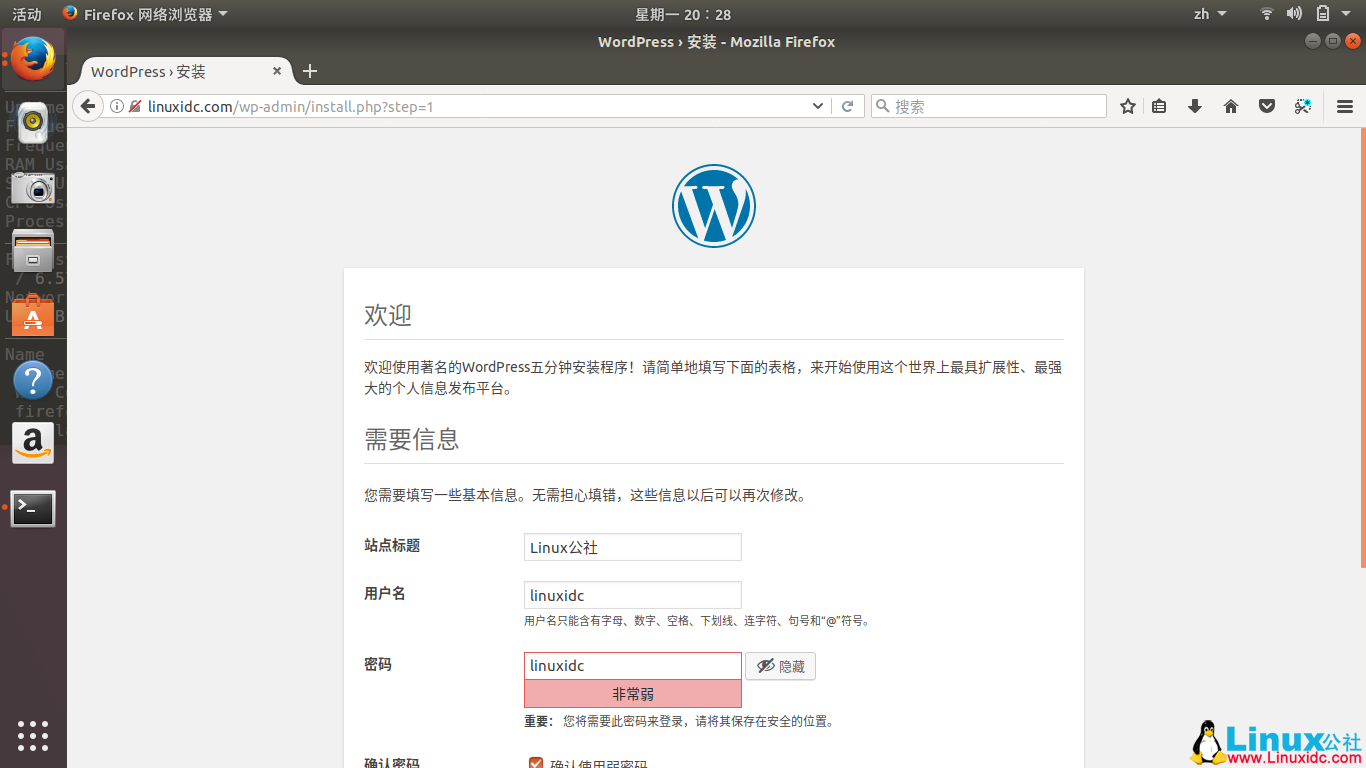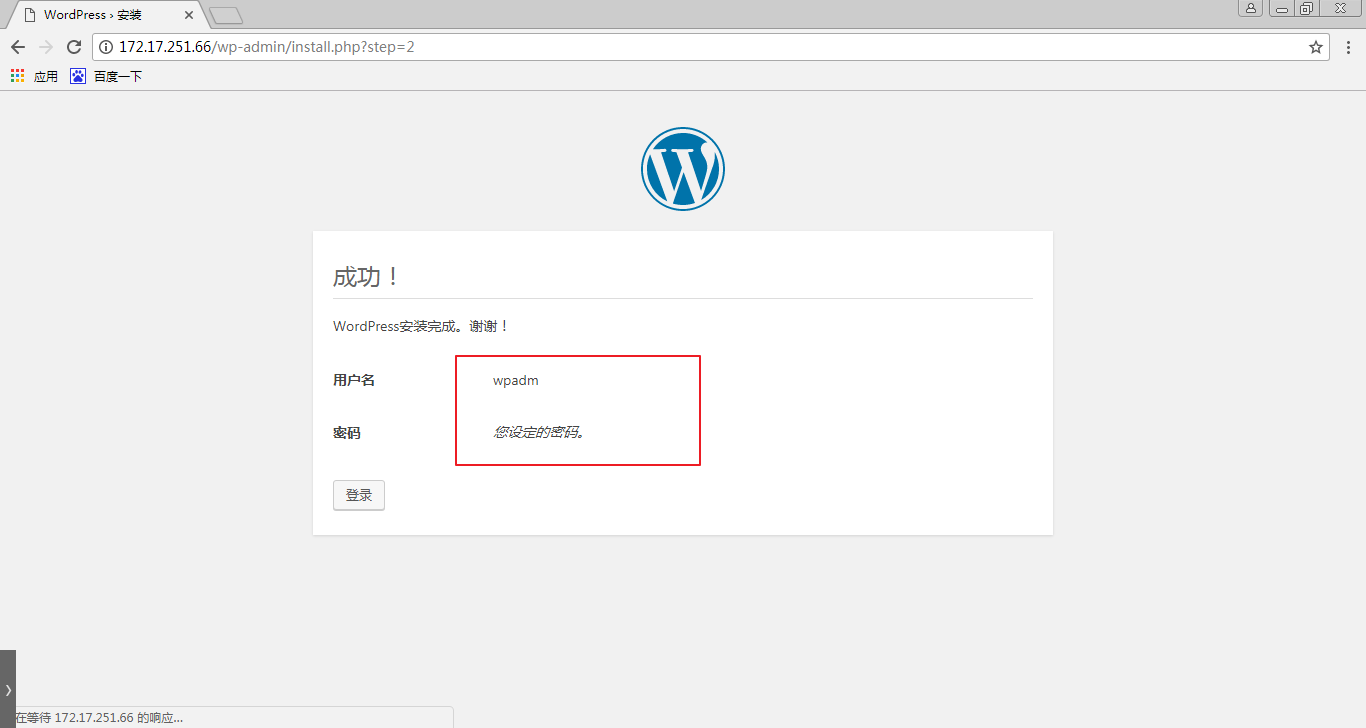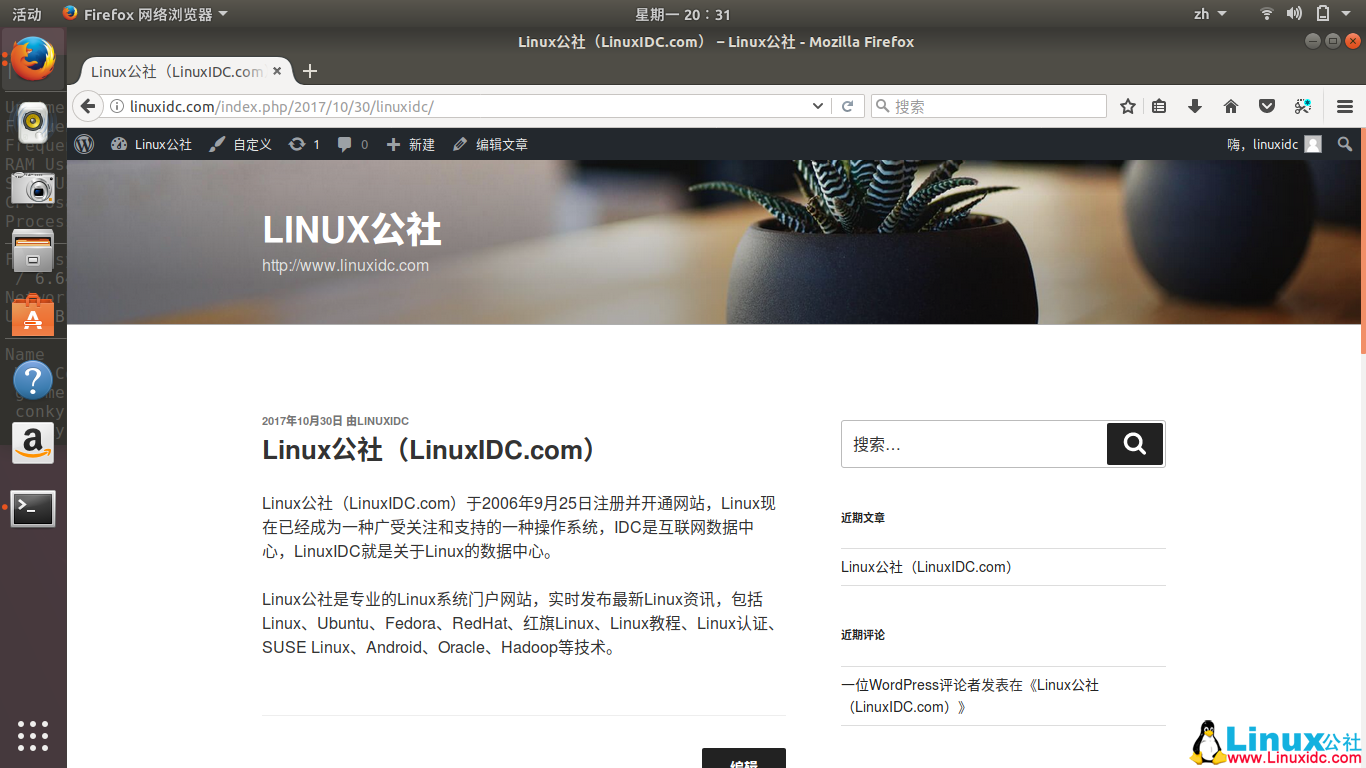共计 11249 个字符,预计需要花费 29 分钟才能阅读完成。
目录
- 原理
- 软件版本
- 实验前准备
- 一、编译安装 httpd2.4
- 1、解包解压缩
- 2、编译安装
- 3、安装后的相关设置
- 二、二进制安装 mariadb-5.5.57
- 1、解包解压缩
- 2、创建逻辑卷
- 2、创建 MySQL 用户
- 3、查看文件
- 4、创建修改配置文件
- 5、执行脚本,创建系统数据库
- 6、创建日志文件
- 7、把服务脚本复制过去
- 8、运行安全初始化脚本
- 9、运行 mysql,创建 wordpress 的数据库和管理员并授权
- 三、安装 php-5.6.31
- 1、解压缩
- 2、进入目录进行编译安装
- 3、创建并编辑配置文件
- 四、修改 http 的主配置文件,让其支持 php
- 五、部署 wordpress
- 1、解压缩并移动文件
- 2、测试登录
- 3、ab 测试性能
- 六、编译安装 xcache
- 1、解包解压缩
- 2、编译安装
- 3、修改配置文件
原理
http使用一次编译法编译安装,php独立服务 fpm 实现。
软件版本
在本次实验中,我们需要用到的软件版本如下:
apr-1.6.2
apr-util-1.6.0
httpd-2.4.28
mariadb-5.5.57
php-5.6.31
wordpress-4.8.1 —- 博客搭建软件
xcache-3.2.0 —- 加速软件
我们先用rz 命令把所有的安装包上传至 /root/src 目录下,以方便我们的实验。
所有的安装包全部在官网下载,下面附上网址:
httpd 官网:http://httpd.apache.org/
apr 官网:http://apr.apache.org/
mariadb 官网:http://mariadb.org/
php 官网:http://php.net/
wordpress 官网:https://cn.wordpress.org/
xcache 官网:http://xcache.lighttpd.net/
实验前准备
提前安装好软件包组及其相关的包:
| yum groupinstall "development tools" -y | |
| yum install openssl-devel \ | |
| expat-devel \ | |
| pcre-devel \ | |
| bzip2-devel \ | |
| libxml2-devel \ | |
| libmcrypt-devel -y |
一共是 1 个包组,6 个包哦~ 大家不要少安,不然会报错的诺。
其中:
openssl-devel expat-devel pcre-devel http 所依赖的包
bzip2-devel libxml2-devel libmcrypt-devel php 所依赖的包
注意:需 epel 扩展源
一、编译安装httpd2.4
1、解包解压缩
我们分别把apr-1.6.2, apr-util-1.6.0 ,httpd-2.4.28 这三个包解压缩:
| tar xvf apr-1.6.2.tar.gz | |
| tar xvf apr-util-1.6.0.tar.gz | |
| tar xvf httpd-2.4.28.tar.bz2 |
然后,我们把 apr-1.6.2/ 和apr-util-1.6.0/文件夹移动到 httpd-2.4.28/ 的指定文件夹中,并改名:
| [] | |
| [] |
2、编译安装
准备工作都做好了,接下来就是编译安装了。
一样的,需要先进入到 httpd-2.4.28/ 这个目录下。由于代码很长,希望大家仔细仔细再仔细,或者像小编一样分行写:
| [root@centos6 src]# cd httpd-2.4.28 | |
| [root@centos6 httpd-2.4.28]# ./configure --prefix=/app/httpd24 \ | |
| --enable-so \ | |
| --enable-ssl \ | |
| --enable-cgi \ | |
| --enable-rewrite \ | |
| --with-zlib \ | |
| --with-pcre \ | |
| --with-included-apr \ | |
| --enable-modules=most \ | |
| --enable-mpms-shared=all \ | |
| --with-mpm=prefork | |
| [root@centos6 httpd-2.4.28]# make -j 4 && make install |
至此,我们的编译安装成功,接下来,我们要修改一些配置。
3、安装后的相关设置
1)修改 PATH 路径
| [root@centos6 httpd-2.4.28]# vim /etc/profile.d/lamp.sh | |
| PATH=/app/httpd24/bin:/usr/local/mysql/bin/:/app/php/bin/:$PATH |
顺便把后边的 mysql 和php的也一起设置进去
接着,运行下面的命令让其生效:
[root@centos6 httpd-2.4.28]# . /etc/profile.d/lamp.sh
2)设置开机自启
我们拷贝一个服务脚本,并对其内容进行修改就可以了:
| [root@centos6 httpd-2.4.28]# cp /etc/init.d/httpd /etc/init.d/httpd24 | |
| [root@centos6 httpd-2.4.28]# vim /etc/init.d/httpd24 |
文件里上面的内容不需要改动,我们只需要修改一下路径就可以了,也就是把
| # Path to the apachectl script, server binary, and short-form for messages. | |
| apachectl=/usr/sbin/apachectl | |
| httpd=${HTTPD-/usr/sbin/httpd} | |
| prog=httpd | |
| pidfile=${PIDFILE-/var/run/httpd/httpd.pid} | |
| lockfile=${LOCKFILE-/var/lock/subsys/httpd} | |
| RETVAL=0 | |
| STOP_TIMEOUT=${STOP_TIMEOUT-10} |
修改为:
| # Path to the apachectl script, server binary, and short-form for messages. | |
| apachectl=/app/httpd24/bin/apachectl | |
| httpd=${HTTPD-/app/httpd24/bin/httpd} | |
| prog=httpd | |
| pidfile=${PIDFILE-/app/httpd24/logs/httpd.pid} | |
| lockfile=${LOCKFILE-/var/lock/subsys/httpd24} | |
| RETVAL=0 | |
| STOP_TIMEOUT=${STOP_TIMEOUT-10} |
然后保存退出就可以了。
接下来,就可以把这个服务添加到服务列表里了:
| [root@centos6 init.d]# chkconfig --add httpd24 | |
| [root@centos6 init.d]# chkconfig httpd24 on | |
| [root@centos6 init.d]# chkconfig --list httpd24 | |
| httpd24 0:off 1:off 2:on 3:on 4:on 5:on 6:off | |
| [root@centos6 init.d]# service httpd24 start |
这样,我们的 httpd2.4 版本 就可以通过 service 来控制了。
同时,我们要开启 httpd 服务。
至此,我们本步骤完成。
二、二进制安装mariadb-5.5.57
1、解包解压缩
tar xvfmariadb-10.2.9-linux-x86_64.tar.gz -C /usr/local/
因为我们是二进制安装,所以必须要指定解压缩的目录为/usr/local/
2、创建逻辑卷
首先,我们先添加一块硬盘,因为这个硬盘要存放数据库,所以尽量大一点,添加硬盘以后,需要输入命令来同步硬盘:
| [] | |
| [] | |
| NAME MAJ:MIN RM SIZE RO TYPE MOUNTPOINT | |
| sr0 11:0 1 3.G 0 rom /mnt/boot | |
| sda 8:0 0 00G 0 disk | |
| ├─sda1 8:1 0 00M 0 part /boot | |
| ├─sda2 8:2 0 3.G 0 part [SWAP] | |
| └─sda3 8:3 0 195.G 0 part / | |
| sdb 8:16 0 00G 0 disk |
如果上面的命令中 host2 不能用的话就改成host0。
然后,我们来创建逻辑卷
| [] | |
| Physical volume "/dev/sdb" successfully created | |
| [] | |
| Volume group "vg_mysqldb" successfully created | |
| [] | |
| Logical volume "lv_mysqldb" created. | |
| [] |
创建好了以后,我们来挂载:
| [root@centos6 src]# mkdir /data/mysqldb -p // 创建挂载点,就是存放数据库的地方 | |
| [root@centos6 src]# vim /etc/fstab // 设置开机挂载,增加一行 | |
| /dev/vg_mysqldb/lv_mysqldb /data/mysqldb ext4 defaults,acl 0 0 | |
| [root@centos6 src]# mount -a // 挂载 |
挂载完成以后,我们接着就可以创建用户了。
2、创建 mysql 用户
因为 mysql 用户是系统用户,所以我们创建的时候要加上 -r
[root@centos7 src]# useradd -d /app/mysqldb -r -m -s /sbin/nologin mysql
-d 指定家目录
-r 创建系统用户
-m 系统用户时没有家目录的,该选项作用是强行指定家目录
-s 指定 shell
创建用户以后,我们把/data/mysqldb/ 的所属人换成 mysql
[root@centos7 src]# chown mysql /data/mysqldb/
3、查看文件
我们使用 cd /usr/local/ 进入解开压缩包的目录,发现 mariadb 的目录名字不符合要求,所以我们可以直接修改名字,也可以创建一个软连接,创建软连接命令如下:
[root@centos7 mysql]# ln -s mariadb-10.2.8-linux-x86_64/ mysql
4、创建修改配置文件
进入 mysql 文件夹,查看 support-files 文件夹中的内容,发现里面有我们的配置文件,但是配置文件不应该在这个目录下,应该放在 /etc/mysql/ 下,所以,我们要创建这个目录,并把配置文件复制进去,具体的操作如下:
| [root@centos7 src]# cd /usr/local/mysql/ | |
| [root@centos7 mysql]# ls | |
| bin include README-wsrep | |
| COPYING INSTALL-BINARY scripts | |
| COPYING.thirdparty lib share | |
| CREDITS man sql-bench | |
| data mysql-test support-files | |
| EXCEPTIONS-CLIENT README.md | |
| [root@centos7 mysql]# ls support-files/ | |
| binary-configure my-medium.cnf policy | |
| magic my-small.cnf wsrep.cnf | |
| my-huge.cnf mysqld_multi.server wsrep_notify | |
| my-innodb-heavy-4G.cnf mysql-log-rotate | |
| my-large.cnf mysql.server | |
| [root@centos7 mysql]# mkdir /etc/mysql | |
| [root@centos7 mysql]# cp support-files/my-huge.cnf /etc/mysql/my.cnf |
接下来,我们来修改配置文件:
| [root@centos7 mysql]# vim /etc/mysql/my.cnf | |
| [mysqld] | |
| datadir = /app/mysqldb // 指定总目录,必须的 | |
| innodb_file_per_table = on // 让每一个表数据库都是一个文件,方便管理 | |
| skip_name_resolve = on // 忽略名字的反向解析,加快速度 |
5、执行脚本,创建系统数据库
首先,我们要确保我们在 /usr/local/mysql 这个目录下,只能在这个目录下执行脚本:
| [] | |
| [] |
执行脚本完成后就会在 /data/mysqldb/ 生成 mysql 系统数据库
6、创建日志文件
| [] | |
| [] |
7、把服务脚本复制过去
| [] | |
| [] | |
| [] |
复制完了以后,我们就可以开启服务了:
[root@centos7 mysql]# service mysqld start
因为我们提前创建了日志文件,所以我们的服务可以正常开启。
8、运行安全初始化脚本
我们在上个大步骤中,已经把所有的 PATH 变量都设置好了,所以现在我们可以直接运行我们的安全初始化脚本:
[root@centos7 mysql]# mysql_secure_installation
9、运行 mysql,创建 wordpress 的数据库和管理员并授权
| [root@centos6 mysql]# mysql -uroot -pcentos | |
| Welcome to the MariaDB monitor. Commands end with ; or \g. | |
| Your MariaDB connection id is 9 | |
| Server version: 5.5.57-MariaDB MariaDB Server | |
| Copyright (c) 2000, 2017, Oracle, MariaDB Corporation Ab and others. | |
| Type 'help;' or '\h' for help. Type '\c' to clear the current input statement. | |
| MariaDB [(none)]> create database blogdb; | |
| Query OK, 1 row affected (0.03 sec) | |
| MariaDB [(none)]> grant all on blogdb.* to 'wpadm'@'172.17.251.66' identified by 'centos';Query OK, 0 rows affected (0.00 sec) | |
| MariaDB [(none)]> quit | |
| Bye |
这样的话,我们的数据库就安装完成。
三、安装php-5.6.31
1、解压缩
tar xvf php-5.6.31.tar.xz
2、进入目录进行编译安装
我们使用 cd 命令进入该目录,然后对 php 进行编译安装:
| [root@centos6 src]# cd php-5.6.31/ | |
| [root@centos7 php-5.6.31]# ./configure \ | |
| --prefix=/app/php \ | |
| --with-mysql=/usr/local/mysql \ | |
| --with-openssl \ | |
| --with-mysqli=/usr/local/mysql/bin/mysql_config \ | |
| --enable-mbstring \ | |
| --with-freetype-dir \ | |
| --with-jpeg-dir \ | |
| --with-png-dir \ | |
| --with-zlib \ | |
| --with-libxml-dir=/usr \ | |
| --enable-xml \ | |
| --enable-sockets \ | |
| --enable-fpm \ | |
| --with-mcrypt \ | |
| --with-config-file-path=/etc/php/ \ | |
| --with-config-file-scan-dir=/etc/php.d \ | |
| --with-bz2 | |
| [root@centos7 5.6.31]# make -j 4 && make install |
3、创建并编辑配置文件
首先,我们要复制配置文件到 /etc 目录下:
| [] | |
| [] | |
| [] | |
| [] |
记得一定要开启执行权限,不然这个服务打不开。
接着,我们来编辑 php 配置文件:
| [] | |
| [] | |
| [] |
注意:在 centos 7 中 php-fpm.conf.default 和 www.conf.default 这两个文件都需要 cp,但 centos 6 把这两个文件合在 php-fpm.conf.default 中了
接下来的这一步不用修改,如果你想根据自己的需要修改也是可以的:
| [root@centos6 etc]# vim /app/php/etc/php-fpm.conf | |
| pm.max_children = 50 | |
| pm.start_servers = 5 | |
| pm.min_spare_servers = 2 | |
| pm.max_spare_servers = 5 // 和 pm.start_servers 一致 | |
| pid = /app/php/var/run/php-fpm.pid |
四、修改 http 的主配置文件,让其支持 php
| [] | |
| // 取消两行对模块的注释,默认被注释了 | |
| LoadModule proxy_module modules/mod_proxy.so | |
| LoadModule proxy_fcgi_module modules/mod_proxy_fcgi.so | |
| // 修改下面行 | |
| DirectoryIndex index.php index.html | |
| // 加下面四行 | |
| AddType application/x-httpd-php .php | |
| AddType application/x-httpd-php-source .phps | |
| ProxyRequests Off | |
| ProxyPassMatch ^/(.*\.php)$ fcgi://127.0.0.1:9000/app/httpd24/htdocs/$1 |
至此,配置结束。
五、部署wordpress
1、解压缩并移动文件
首先,我们进行解压缩:
tar xvf wordpress-4.8.1-zh_CN.tar.gz
然后,把该文件夹中的文件全部移动到 /app/httpd24/htdocs/ 这个目录下:
| [] | |
| [] | |
| [] | |
| [] |
接着,我们进入 /app/httpd24/htdocs/ 这个文件夹,查看文件:
| [root@centos7 wordpress]# cd /app/httpd24/htdocs/ | |
| [root@centos7 htdocs]# ls | |
| a.php wp-blog-header.php wp-load.php | |
| index.html wp-comments-post.php wp-login.php | |
| index.php wp-mail.php license.txt | |
| wp-config-sample.php wp-settings.php pma | |
| wp-content wp-signup.php readme.html | |
| wp-cron.php wp-trackback.php wp-activate.php | |
| wp-includes xmlrpc.php wp-admin | |
| wp-links-opml.php |
我们可以看到这里面有一个 wp-config-sample.php 文件,我们复制一份并改名,接着编辑:
| [] | |
| [] |
我们只需要修改四行的内容,也就是我们上一步中设置的数据库账号的相关内容:
| /** WordPress 数据库的名称 */ | |
| define('DB_NAME', 'blogdb'); | |
| /** MySQL 数据库用户名 */ | |
| define('DB_USER', 'wpadm'); | |
| /** MySQL 数据库密码 */ | |
| define('DB_PASSWORD', 'centos'); | |
| /** MySQL 主机 */ | |
| define('DB_HOST', '172.17.251.66'); |
2、测试登录
修改完成之后,我们直接浏览器登录测试就可以了:
填写完相关的内容,然后点击左下角的安装wordpress
我们的博客就这么搭建好了,我们可以登录进去试试看:
3、ab 测试性能
ab -c 10 -n 100 http://172.17.251.66/
速度大概在 6.2 左右。
六、编译安装 xcache
1、解包解压缩
tar xvf xcache-3.2.0.tar.gz
2、编译安装
首先,我们进入该目录:
| [] | |
| [] | |
| AUTHORS Makefile.frag run-xcachetest | |
| bin Makefile.frag.deps tests | |
| ChangeLog mod_assembler THANKS | |
| config.m4 mod_cacher util | |
| config.w32 mod_coverager xcache | |
| COPYING mod_decoder xcache.c | |
| devel mod_disassembler xcache_globals.h | |
| gen_structinfo.awk mod_encoder xcache.h | |
| htdocs mod_optimizer xcache.ini | |
| includes.c NEWS xcache-test.ini | |
| INSTALL processor xcache-zh-gb2312.ini | |
| lib README |
我们在目录中并没有找到 configure 脚本,所以我们要进行生成:
| [] | |
| [] | |
| [] | |
| acinclude.m4 htdocs mod_optimizer | |
| aclocal.m4 includes.c NEWS | |
| AUTHORS INSTALL processor | |
| autom4te.cache install-sh README | |
| bin lib run-tests.php | |
| build ltmain.sh run-xcachetest | |
| ChangeLog Makefile.frag tests | |
| config.guess Makefile.frag.deps THANKS | |
| config.h.in Makefile.global util | |
| config.m4 missing xcache | |
| config.sub mkinstalldirs xcache.c | |
| configure mod_assembler xcache_globals.h | |
| configure.in mod_cacher xcache.h | |
| config.w32 mod_coverager xcache.ini | |
| COPYING mod_decoder xcache-test.ini | |
| devel mod_disassembler xcache-zh-gb2312.ini | |
| gen_structinfo.awk mod_encoder |
接着,我们就可以进行编译安装了:
| ./configure --enable-xcache --with-php-config=/app/php/bin/php-config | |
| make && make install |
3、修改配置文件
首先,我们来复制一下文件:
| [root@centos6 xcache-3.2.0]# mkdir /etc/php.d/ | |
| [root@centos6 xcache-3.2.0]# cp xcache.ini /etc/php.d/ | |
| [root@centos6 xcache-3.2.0]# ls /app/php/lib/php/extensions/ | |
| no-debug-non-zts-20131226 |
接着我们就可以对配置文件进行修改:
[root@centos6 xcache-3.2.0]# vim /etc/php.d/xcache.ini
因为是源码编译,xcache 不是放在对应路径下,所以需要对其路径进行修改,也就是需要修改下面这一行:
extension = /app/php/lib/php/extensions/no-debug-non-zts-20131226/xcache.so
修改完成后,我们就可以启动服务了:
[root@centos6 xcache-3.2.0]# service php-fpm restart
启动服务以后,我们在对其进行性能测试:
ab -c 10 -n 100 http://172.17.251.66/
速度提升到了 16,我们的加速器成功 0.0
至此,我们的实验圆满完成。
本文永久更新链接地址:http://www.linuxidc.com/Linux/2017-11/148577.htm















